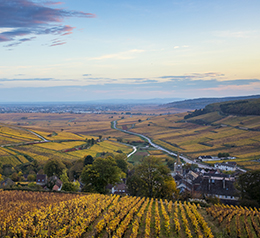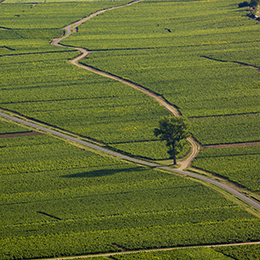In the rolling landscape around Beaune, the winemakers produce some world-renowned appellations. Come and discover these characterful red and white wines like Volnay, Meursault Premier Cru or Montrachet, one of the most famous Grands Crus in the world.
In the past, all the wines of the Côte de Beaune were called “Vin de Beaune.”
Back in the Middle Ages, the Dukes of Bourgogne appreciated the lively temperament of the wines produced on the Côte de Beaune. They even helped boost the reputation of the wines, as did the monks. Back then, the wines bore the not-very-distinctive name “Vin de Beaune” or “Pinot Vermeil,” in reference to the Pinot Noir varietal used to make them.
Similarly, the name “Vin de Nuits” was used to describe all the wines from the Côte de Nuits.
It wasn’t until 1936 that the wines were classified according to the Appellation d’Origine Contrôlée system.

Between Ladoix-Serrigny and the hillsides of the Maranges, the Côte de Beaune winegrowing region covers 20km from north to south. Facing the morning sun, these vineyards are never more than a few hundred meters wide. Yet they produce red and white wines that are internationally renowned. Their reputation also extends to the town of Beaune, an historical center where you can discover all the secrets of Bourgogne.
A little farther to the west, behind the Côte de Beaune, the vines flourish on a gently concave plateau, 400m above sea level. This is the Hautes Côtes de Beaune. On the sunniest slopes, around 20 communes produce lively and accessible wines from the Bourgogne Hautes Côtes de Beaune appellation.

Around the town of Beaune, the vineyards are mainly planted with Pinot Noir (Volnay, Pommard, Ladoix, etc.), although the Chardonnay grape produces a few marvels on the Corton hill (Corton, Corton-Charlemagne). From Meursault onwards, the Chardonnay grape dominates, producing wines that are very diverse in terms of their aromatic profile, between legendary appellations such as Bâtard-Montrachet and less well-known treasures such as Saint-Aubin and Santenay.
Local winemakers produce famous appellations from these two varietals typically used in Bourgogne.
They also make some tempting appellations Régionales: Bourgogne, Bourgogne Aligoté, Bourgogne Passe-Tout-Grains, Coteaux Bourguignons and Crémant de Bourgogne et Bourgogne Côte d'Or.
A story to help remember the names of Montrachet’s Grands Crus…
A legendary Bourgogne name, Montrachet is the cradle of five white Grands Crus; Montrachet, Bâtard-Montrachet, Chevalier-Montrachet, Bienvenues-Bâtard-Montrachet and Criots-Bâtard-Montrachet.
To remember their names, try to memorize this tale:
The Seigneur of Montrachet set off on a crusade, entrusting his virgin daughter to his favorite Chevalier (knight).
In his absence, what happened, happened, and a child was born illegitimately.
On his return from the Crusades, the Seigneur discovered this Bâtard (bastard), who started to cry when he saw him. The Seigneur then said: “Criots-Bâtard!” (The bastard cries!).
But he was a good man, and welcomed the child into the family with these words: “Bienvenues-Bâtard-Montrachet” (Welcome, Bastard of Montrachet).